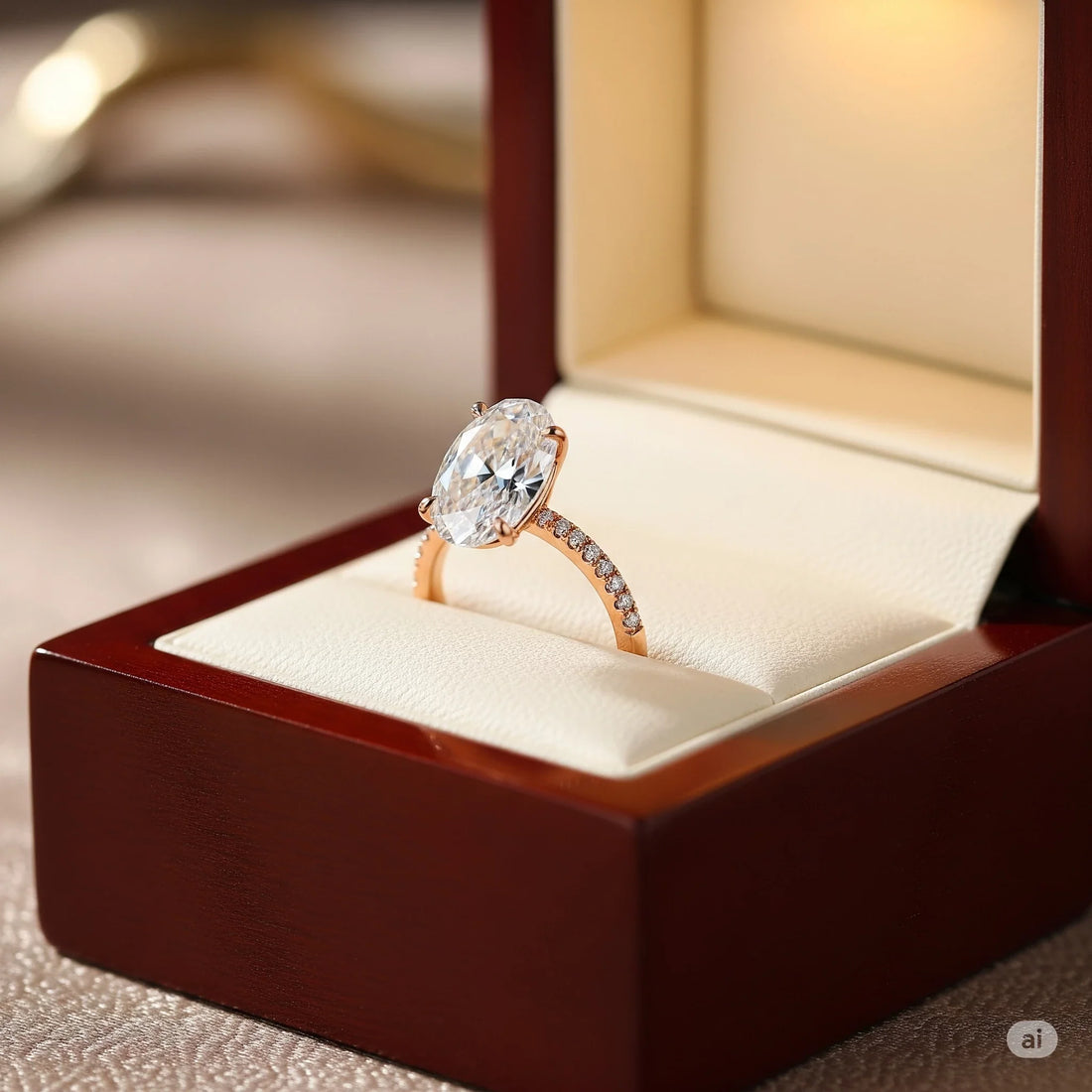
The Future of Lab Grown Diamonds: Trends for 2025 and Beyond
Share
The future of lab grown diamonds is reshaping the jewelry industry in unprecedented ways. As we approach 2025, laboratory-created diamonds are no longer considered an alternative to natural diamonds—they're becoming the preferred choice for environmentally conscious consumers, tech-savvy millennials, and budget-aware shoppers. This comprehensive guide explores the emerging trends, technological innovations, and market predictions that will define the lab-grown diamond landscape in the coming years.

Current State of the Lab-Grown Diamond Market
The lab-grown diamond industry has experienced explosive growth over the past decade. In 2023, lab-created diamonds captured approximately 20% of the global diamond market, a figure that industry experts predict will double by 2030. This remarkable expansion reflects changing consumer preferences, improved manufacturing techniques, and increased awareness of ethical sourcing concerns.
Major jewelry retailers have embraced this shift, with companies like Pandora, Signet Jewelers, and even luxury brands incorporating lab-grown diamonds into their collections. The diamond industry trends clearly indicate that synthetic diamonds are no longer a niche product but a mainstream jewelry option.
Market Size and Growth Projections
Current market analysis reveals that the global lab-grown diamond market was valued at approximately $22 billion in 2023. Industry forecasts suggest this figure will reach $55 billion by 2030, representing a compound annual growth rate (CAGR) of 14.2%. This growth trajectory positions lab-created diamonds as one of the fastest-growing segments in the luxury goods sector.
- North America leads consumption with 45% market share
- Asia-Pacific shows the highest growth potential at 18% CAGR
- Europe maintains steady demand with focus on sustainability
- Emerging markets in Latin America and Africa show increasing interest
Technological Innovations Driving the Future
The future technology behind lab-grown diamond production continues to evolve rapidly. Two primary methods dominate the industry: High Pressure High Temperature (HPHT) and Chemical Vapor Deposition (CVD). Both techniques are becoming more sophisticated, efficient, and cost-effective.

Advanced CVD Technology
Chemical Vapor Deposition technology has seen remarkable improvements in recent years. Modern CVD reactors can now produce larger diamonds with fewer inclusions and better color grades. The latest innovations include:
- Plasma-enhanced CVD systems that reduce growth time by 40%
- Multi-chamber reactors enabling simultaneous diamond production
- Improved gas mixture formulations for enhanced crystal quality
- Real-time monitoring systems for precise growth control
HPHT Method Enhancements
High Pressure High Temperature technology has also advanced significantly. New press designs and temperature control systems allow for more consistent diamond production. Recent developments include:
- Automated pressure regulation systems
- Enhanced seed crystal preparation techniques
- Improved metal catalyst formulations
- Energy-efficient heating mechanisms
Emerging Trends for 2025 and Beyond
Several key trends will shape the future of lab grown diamonds as we move toward 2025 and beyond. These developments span technological innovation, consumer behavior, and industry practices.
Sustainability and Environmental Impact
Environmental consciousness continues to drive consumer preferences toward lab-grown diamonds. Unlike traditional mining, laboratory diamond production has a significantly smaller carbon footprint and eliminates concerns about land disruption and water pollution. Carbon-neutral diamond production is becoming a reality as manufacturers invest in renewable energy sources.

Key sustainability initiatives include:
- Solar and wind-powered production facilities
- Closed-loop water recycling systems
- Zero-waste manufacturing processes
- Carbon offset programs for remaining emissions
Customization and Personalization
The ability to create diamonds with specific characteristics is revolutionizing jewelry design. Consumers can now order diamonds with particular colors, sizes, and even custom engravings at the molecular level. This trend toward personalized diamond jewelry is expected to accelerate through 2025.
Colored Diamond Innovation
Lab-grown colored diamonds represent one of the most exciting growth areas. While natural colored diamonds are extremely rare and expensive, laboratory techniques can produce vibrant blues, pinks, yellows, and even exotic colors like orange and green at accessible price points.
Market Predictions and Industry Forecasts
Industry analysts have developed comprehensive market predictions for the lab-grown diamond sector. These forecasts consider technological advancement, consumer adoption rates, and competitive dynamics.
Price Trends and Accessibility
Lab-grown diamond prices are expected to continue declining as production scales up and technology improves. Current pricing shows lab-created diamonds cost 60-80% less than natural diamonds of comparable quality. By 2025, this price differential may widen further, making high-quality diamonds accessible to a broader consumer base.

Quality Improvements
Diamond quality continues to improve across all production methods. Future developments will focus on:
- Achieving consistent Type IIa diamond production
- Eliminating trace nitrogen and boron impurities
- Producing larger carat weights with maintained quality
- Developing new color varieties through controlled doping
Consumer Behavior and Preferences
Understanding evolving consumer preferences is crucial for predicting the future of lab grown diamonds. Research indicates significant generational differences in diamond purchasing decisions.
Millennial and Gen Z Adoption
Younger consumers show strong preference for lab-grown diamonds, driven by:
- Ethical considerations regarding mining practices
- Environmental sustainability concerns
- Value consciousness and budget optimization
- Technology appreciation and innovation acceptance
Luxury Market Integration
High-end jewelry brands are increasingly incorporating lab-grown diamonds into their collections. This trend legitimizes synthetic diamonds in the luxury market and expands their appeal to affluent consumers who previously preferred natural stones.

Industry Challenges and Solutions
Despite rapid growth, the lab-grown diamond industry faces several challenges that will influence its future trajectory.
Detection and Certification
As lab-grown diamonds become increasingly sophisticated, detection methods must evolve accordingly. Advanced spectroscopy and photoluminescence techniques are being developed to ensure proper identification and certification.
Market Education
Consumer education remains a significant challenge. Many potential buyers lack understanding of lab-grown diamond properties, benefits, and quality standards. Industry initiatives focus on:
- Transparent marketing and labeling practices
- Educational content and resources
- Professional training for jewelry retailers
- Standardized grading and certification systems
Investment and Business Opportunities
The expanding lab-grown diamond market presents numerous investment opportunities across the value chain. From production technology to retail distribution, various sectors offer growth potential.
Manufacturing and Technology
Investment in diamond production technology continues to attract venture capital and private equity funding. Key areas include:
- Equipment manufacturing and automation
- Process optimization and quality control
- Research and development initiatives
- Scaling production capacity
Retail and Distribution
Retail opportunities span from specialized lab-grown diamond boutiques to online marketplaces. Direct-to-consumer brands are particularly successful in this space, offering competitive pricing and educational resources.

Global Market Dynamics
Regional differences in lab-grown diamond adoption reflect varying consumer preferences, regulatory environments, and economic conditions.
North American Market
The United States leads global consumption of lab-grown diamonds, driven by strong consumer awareness and acceptance. Canada's mining heritage creates interesting market dynamics as consumers balance traditional preferences with modern alternatives.
Asian Markets
China and India represent significant growth opportunities, with large populations of young, tech-savvy consumers. Local production capabilities are expanding rapidly, potentially making these regions major suppliers as well as consumers.
European Trends
European consumers show strong preference for sustainable and ethically sourced products, making lab-grown diamonds particularly appealing. Regulatory frameworks supporting environmental responsibility further encourage adoption.
Future Applications Beyond Jewelry
While jewelry remains the primary application, lab-grown diamonds have expanding uses in industrial and technological applications.
Industrial Applications
Diamond's exceptional hardness and thermal conductivity make it valuable for:
- Cutting tools and abrasives
- Heat sinks for electronic components
- Optical components and windows
- Quantum computing applications
Emerging Technologies
Research into diamond-based technologies continues expanding potential applications. Quantum sensors and computing components represent particularly promising areas for future development.

Frequently Asked Questions
Are lab-grown diamonds real diamonds?
Yes, lab-grown diamonds are chemically, physically, and optically identical to natural diamonds. They consist of pure carbon arranged in the same crystal structure and exhibit identical properties including hardness, brilliance, and fire.
How can you tell the difference between lab-grown and natural diamonds?
Professional gemological equipment is required to distinguish between lab-grown and natural diamonds. Advanced spectroscopy and photoluminescence analysis can detect subtle differences in trace elements and growth patterns.
Do lab-grown diamonds hold their value?
Lab-grown diamonds typically have lower resale values than natural diamonds due to their lower production costs and increasing supply. However, they offer excellent value for consumers seeking diamond jewelry at accessible prices.
What sizes are available in lab-grown diamonds?
Lab-grown diamonds are available in sizes ranging from small accent stones to large center stones exceeding 10 carats. Production capabilities continue expanding, with larger sizes becoming more readily available.
Are lab-grown diamonds environmentally friendly?
Lab-grown diamonds have a significantly smaller environmental footprint than mined diamonds. They require no land excavation, use less water, and produce fewer carbon emissions, especially when powered by renewable energy sources.
Can lab-grown diamonds be certified?
Yes, reputable gemological institutes including GIA, IGI, and GCAL provide certification for lab-grown diamonds. These certificates detail the diamond's characteristics and confirm its laboratory origin.
Making the Right Choice for Your Diamond Purchase
When considering lab-grown diamonds for your jewelry purchase, several factors deserve careful consideration. Quality, certification, and retailer reputation remain paramount regardless of diamond origin.
Evaluate your priorities regarding budget, environmental impact, and personal preferences. Lab-grown diamonds offer exceptional value, ethical sourcing, and identical beauty to natural diamonds. For many consumers, these advantages make laboratory-created diamonds the preferred choice.
Consider the intended use of your diamond jewelry. Engagement rings, anniversary gifts, and special occasion pieces all benefit from the superior value proposition of lab-grown diamonds, allowing you to maximize size and quality within your budget.

The future of lab grown diamonds promises continued innovation, improved quality, and expanding accessibility. As technology advances and consumer acceptance grows, laboratory-created diamonds will likely become the dominant choice for diamond jewelry purchases.
Ready to explore the brilliant future of lab-grown diamonds? Discover our extensive collection of certified lab-grown diamond jewelry and experience the perfect combination of beauty, value, and ethical sourcing. Our expert gemologists are available to help you find the ideal diamond for your special moment, backed by comprehensive warranties and lifetime support services.
